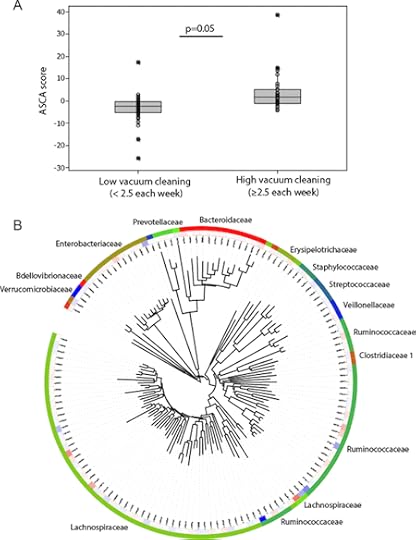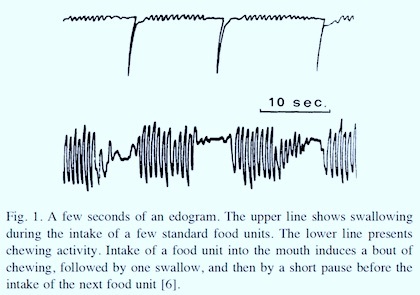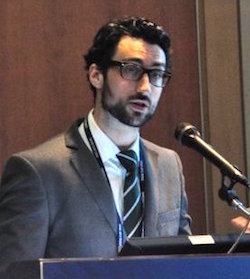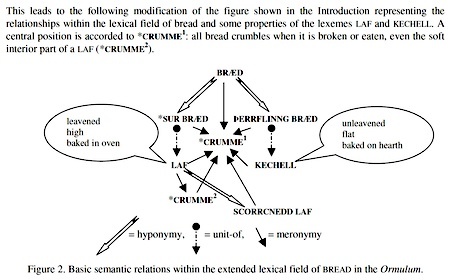Marc Abrahams's Blog, page 290
December 25, 2015
Enter, pursued by a bear
Do you share the Christmas tradition of watching “Project Grizzly“, the documentary film about Ig Nobel Prize winner Troy Hurtubise? Here’s the film:
Troy was awarded the 1998 Ig Nobel Prize for safety engineering, for Troy Hurtubise, of North Bay, Ontario, for developing, and personally testing a suit of armor that is impervious to grizzly bears.
BONUS: Farewell, Treadwell. Praised Be Troy. (About, among other things, the movie “Grizzly Man“, with a cameo of sorts by Leonardo DiCaprio.)
BONUS: Troy’s book about his research into bear-proof suits

December 24, 2015
The special Ig Nobel issue of the magazine!
The special IG NOBEL issue (vol. 21, no. 6) of the magazine (the Annals of Improbable Research) is now out!
Articles include:
“The 2015 Ig Nobel Prize Ceremony“
“Improbable Sex“
…and more, more, more, including outstandingly improbable research snippets from many fields and countries.
We encourage you to subscribe (or, if you like, buy it as a single issue).

Button-down shirts, analyzed academically by Nathaniel Weiner
Subculture researcher Nathaniel Weiner, (PhD candidate in York University and Ryerson University’s joint PhD program in Communication and Culture) uses Roland Barthes’ notion of ‘fashion narrative’ to elucidate the close relationship between the button-down shirt and the ‘national imaginaries’ of the United States and Britain, in: Transatlantic Translations of the Button-down Shirt (in the journal TranscUlturAl, Vol 6, #1)
Also see (shirt research related): Hawaiian shirts under the spotlight of rubbish theory
Bonus (Button-Down, not really shirt related) The Button-Down Mind of Bob Newhart

December 23, 2015
Vacuum Cleaning and Pregnancy in Houses
A rare study about vacuum-cleaning, pregnancy, and microbes, in houses:
“Potential association of vacuum cleaning frequency with an altered gut microbiota in pregnant women and their 2-year-old children,” Ekaterina Avershina, Anuradha Ravi, Ola Storrø, Torbjørn Øien, Roar Johnsen and Knut Rudi, Microbiome, vol. 3, no. 65, December 21, 2015. (Thanks to Rom Gavitz for bringing this to our attention.) The researchers, at Norwegian University of Life Sciences, report:
“We found that high vacuum cleaning frequency about twice or more a week was associated with an altered gut microbiota composition both during pregnancy and for 2-year-old children, while there were no associations with house washing frequency.”
Here’s part 1 of a music video by Aliqua about how to vacuum your house:
And here’s further detail from the study:


Podcast #43: The impossible expertise of self-proclaimed experts
Self-proclaimed experts, and the twists and turns of people chewing and swallowing — these are the things that turn up in this week’s Improbable Research podcast.
LISTEN TO IT! …or click on the “Venetian blinds” icon — at the lower right corner here — to select whichever week’s episode you want to hear:
SUBSCRIBE on Play.it, iTunes, or Spotify to get a new episode every week, free.
This week, Marc Abrahams tells about:
The impossible expertise of self-proclaimed experts. (The Dunning-Kruger Effect / “When Knowledge Knows No Bounds — Self-Perceived Expertise Predicts Claims of Impossible Knowledge,” Stav Atir, Emily Rosenzweig, David Dunning, Psychological Science, vol. 26 no. 8, 2015, pp. 1295-1303. /
 “Unskilled and Unaware of It: How Difficulties in Recognizing One’s Own Incompetence Lead to Inflated Self-Assessments,” David Dunning and Justin Kruger, Journal of Personality and Social Psychology, vol. 77, no. 6, December 1999, pp. 1121-34. Featuring dramatic readings by Robin Abrahams.)
“Unskilled and Unaware of It: How Difficulties in Recognizing One’s Own Incompetence Lead to Inflated Self-Assessments,” David Dunning and Justin Kruger, Journal of Personality and Social Psychology, vol. 77, no. 6, December 1999, pp. 1121-34. Featuring dramatic readings by Robin Abrahams.)Chewing and swallowing research. (Bellisle, France, B. Guy-Grand, and J. Le Magnen (2000). ‘Chewing and Swallowing as Indices of the Stimulation to Eat During Meals in Humans: Effects Revealed by the Edogram Method and Video Recordings.’ Neuroscience and Biobehavioral Reviews 24 (2): 223–28. /
 Bellisle, France, and Anne-Marie Dalix (2001). ‘Cognitive Restraint Can Be Offset by Distraction, Leading to Increased Meal Intake in Women.’ American Journal of Clinical Nutrition 74 (2): 197–200. Featuring dramatic readings by Jean Berko Gleason.) Here’s detail from the “Chewing and swallowing” study:
Bellisle, France, and Anne-Marie Dalix (2001). ‘Cognitive Restraint Can Be Offset by Distraction, Leading to Increased Meal Intake in Women.’ American Journal of Clinical Nutrition 74 (2): 197–200. Featuring dramatic readings by Jean Berko Gleason.) Here’s detail from the “Chewing and swallowing” study: 
The mysterious John Schedler or the shadowy Bruce Petschek perhaps did the sound engineering this week.
The Improbable Research podcast is all about research that makes people LAUGH, then THINK — real research, about anything and everything, from everywhere —research that may be good or bad, important or trivial, valuable or worthless. CBS distributes it, on the CBS Play.it web site, and on iTunes and Spotify).

December 22, 2015
For Specialists: Bread, Crumbs, and Related Matters in the Ormulum
For those who are savvy about the Ormulum, new insights await as to bread, crumbs, and related matters. Details are in the study:
“Bread, Crumbs, and Related Matters in the Ormulum,” Nils-Lennart Johannesson [pictured here], In Selected Proceedings of the 2005 Symposium on New Approaches in English Historical Lexis (HEL-LEX), pp. 69-82. 2006. The author, at Stockholm University, begins by explaining:
“The lexical field of BREAD in the language of the Ormulum is made up of four lexemes, namely BRÆD, LAF, KECHELL, and *CRUMME (only attested in the the plural form crummess). Orm’s language, just like Modern English, had different words for bread as a substance (BRÆD) and as a unit of production (LAF). Old English, by contrast, had only the single word HL F corresponding, just like Latin PANIS, to both of these.”
Here’s detail from the study:

December 21, 2015
High-achieving professors’ brains – are they different (to low-achieving professors’)?
A new (and possibly unique) research project has performed detailed examinations of the physical structure of the brains of high-achieving university professors. More specifically, Chinese high-achieving university professors. Or, to be precise, male Chinese high-achieving university professors. Inspired (in part) by a 1999 study entitled ‘The exceptional brain of Albert Einstein’ (in: The Lancet, vol. 353, pp. 2149–2153) [which examined the structure Einstein’s brain using measurements and photographs of slices of it which had been taken at his post-mortem] investigators Weiwei Li, Wenjing Yang, Wenfu Li, Yadan Li, Dongtao Wei, Huimin Li, Jiang Qiu, and Qinglin Zhang looked instead at ‘Brain Structure and Resting-State Functional Connectivity in University Professors with High Academic Achievement’ (in: Creativity Research Journal, 27(2), pp. 139–150)
This time though, they opted for MRI scans rather than dissections. The heads of 22 professorial subjects were scanned, having been divided into two groups – the high-achieving professors (HAPs) (viz. those with more awards, honors, and research achievements; and who had presided over more national research projects and provincial research projects in China) and low-achieving professors (LAPs)
“During rs-fMRI data scanning, participants laid supinely with their heads comfortably fixed by birdcage head coil and padded with foam to minimize head movement. Earplugs were used to reduce the influence of scanner noise. Participants were asked to close eyes lightly, keep still as much as possible, not to think about anything and sleepy. [sic]”
Voxel-based morphometry analysis of the resulting scans revealed that :
“[…] HAP had greater rGMV in the left inferior frontal gyrus (mainly in the posterior orbital frontal gyrus, OFG) and supplementary motor cortex (SMA), which might be associated with effective behavioral and cognitive planning and execution; smaller rGMV in the right medial prefrontal gyrus (mPFC) and right inferior parietal lobule (IPL), which might be related to increased novelty seeking and hypothetical thinking. Functional connectivity analysis revealed interactions between some specific brain regions in HAP when the left OFG, the left SMA and the left postcentralgyrus (PCG) were used as seed regions, which indicated that the interactions between these brain regions might be critically involved in professors’ intellectual and creative abilities.”
The investigators do add a corollary though :
“There is no denying that every scientific research has more or less limitations. This study also has some limitations. For example, the differences in brain structure and functional connectivity might be influenced by many factors: language expertise, math expertise, music expertise, working memory, attention, knowledge, etc. Moreover, a limitation exists in this study with small sample.”
Also see (fMRI brain-scan related): fMRI and Forrest Gump Open Science

December 20, 2015
Rats! Curses! Automation!
This study, from one of the many golden ages of psychology, now supplies data for researchers who wish to try to analyze the psychology of researchers who developed an apparatus which allows for the thoroughly automated monitoring and recording of shock-elicited vocalization in rats:
“An automated apparatus for recording shock elicited vocalization in the rat,” Hank Davis, David Perrott [pictured here], James Hubbard, Psychological Record, vol 22(1), 1972, pp. 71-74. The authors explain:
“Describes an apparatus which allows for the thoroughly automated monitoring and recording of shock-elicited vocalization in rats. The apparatus involves converting an auditory signal into an oscilloscope trace which, in turn, triggers a photoelectric relay and all the necessary recording equipment.”

December 19, 2015
Fetish: Americans Shooting Themselves in the Foot
 Theodore Cosco [pictured here], who is a past president of the Cambridge University Clay Pigeon Shooting Club, and James Harmsworth King display their unusual across-the-sea foot fetish, in this study:
Theodore Cosco [pictured here], who is a past president of the Cambridge University Clay Pigeon Shooting Club, and James Harmsworth King display their unusual across-the-sea foot fetish, in this study:
“Americans shooting themselves in the foot: the epidemiology of podiatric self-inflicted gunshot wounds in the United States,” Theodore D. Cosco and James H. King, Medical Journal of Australia, 2015; 203 (11): 458-461. The authors, at the University of Cambridge, UK, report:
Design: Data from the Firearm Injury Surveillance Study (1993–2010) collected using the National Electronic Injury Surveillance System were examined. Non-fatal firearm-related injuries were recorded during patients’ initial emergency department visits.
Setting: United States hospital emergency departments, 1993–2010.
Results: Of the 69 111 reported firearm-related injuries, 667 (1.0%) were self-inflicted gunshot wounds to the foot. Of these, 597 of the patients (89.6%) were men and 51.7% (345) were aged between 15 and 34 years…. Those who shot themselves in the foot were significantly more likely than individuals with other firearm-related injuries to be male (odds ratio [OR], 1.28) and married (OR, 2.6). As the festive season approached, the number of incidents increased; November and December were peak months for shooting oneself in the foot.
Ivan Oransky, writing in MedPage Today, gives an appreciation of this appreciation of foot-shooting.

Kelsey Dobson and Stephen Lindeman review a urination duration lecture
Kelsey Dobson and Stephen Lindeman attended a lecture by David Hu, who was awarded an Ig Nobel Prize this year for his research on urination duration in mammals. Dobson and Lindeman each then reviewed what they had seen and hears:

Marc Abrahams's Blog
- Marc Abrahams's profile
- 14 followers






